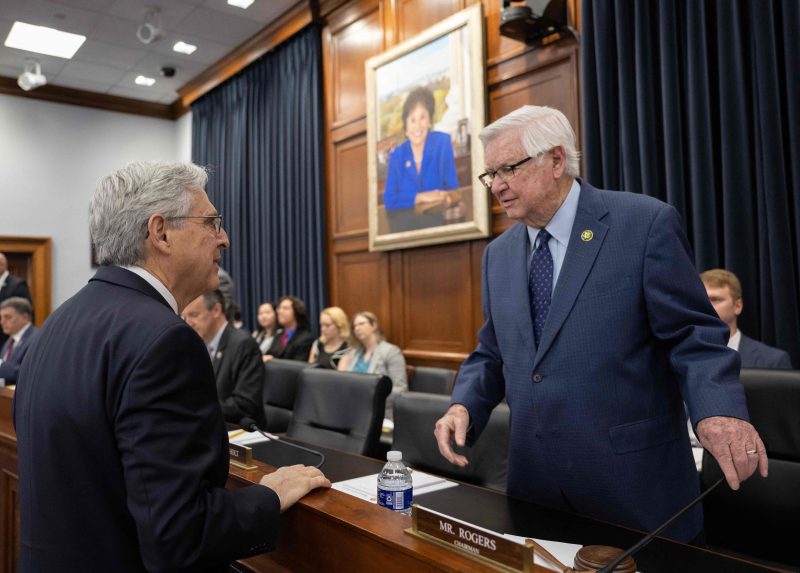After the 1996 elections, Kentucky’s 5th Congressional District served as a crucial swing region in a true battleground state: Republican Bob Dole edged President Bill Clinton there, but the Democrat narrowly won the state’s eight electoral votes.
The district sat almost at the country’s political center, with almost 200 congressional districts rated more conservative and about 235 more liberal, according to one detailed analysis.
Today, as the 2024 presidential season gets started, Kentucky’s 5th is the second-most-conservative district in the entire nation. Its representative has not changed — the dean of the House, Hal Rogers, has ruled the district for more than 42 years — but his rural constituents, many with roots in the coal economy, have shifted dramatically to the right.
David Wasserman, senior editor of the Cook Political Report with Amy Walter, highlights the Kentucky district in a new deep dive into all 435 House districts to explain the geographical roots of political polarization and how hollowed-out the political middle has become.
Although legislative gerrymandering plays a key role in letting representatives choose their constituents, the nation’s “urban/rural polarization” has been a much bigger factor over the past 25 years, Wasserman wrote.
“The electorate has simply become much more homogenous than it used to be,” he wrote in the newly released analysis.
It’s part of a nationwide realignment highlighted by the new rankings of the “Cook Partisan Voting Index,” which operatives in both parties have examined for years to help determine which districts are truly up for grabs every two years.
Districts like Rogers’s in Appalachia now have more in common with a rural district nearly 900 miles away in eastern Oklahoma — in terms of income and education levels, home property values and the number of people living in poverty — than Kentucky’s 6th District directly to the north and west.
And the result, politically, is that Kentucky’s 5th and Oklahoma’s 2nd districts gave Donald Trump two of his five biggest margins of victory in 2016 and 2020, greater than 50 percentage points in each campaign.
Wasserman and the Cook team, in their PVI reports every two years, have documented the decline of legitimate swing districts, those House seats that have a chance of being flipped every two years.
Rather than looking at the margin by which members of Congress won their most recent races, they analyze how districts’ voters cast ballots in the past two presidential elections in comparison with the national average of the popular votes.
If the average national popular vote was 50 percent to 48 percent in favor of the Democrats, a district in which Trump hit 53 percent would be considered five percentage points above average, or “R+5,” as insiders say. A seat where the Democratic average hit 55 percent would likewise be five percentage points above average, or “D+5.”
In this current Congress, not a single Republican holds a seat that rates D+6 or higher, and just two Democrats, Reps. Jared Golden (Maine) and Mary Peltola (Alaska), hold seats at R+6 or higher.
Instead, all the rest of the swing seats sit inside that “+5” range and, because Wasserman’s team released all the data for House districts going back to 1997, this analysis is a great lens into the disappearing middle ground on Capitol Hill.
In 1999, 164 seats fell into that Cook PVI margin to qualify as swing seats. Now, just 82 fit that statistical data point. Moreover, the number of seats that are competitive in every election season — “hyper-swing seats” that fall inside “D+3-to-R+3” range — has shrunk at a faster rate.
“Today there are just 45 seats between those benchmarks, a 58 percent decline from the high-water mark of 107 in 1999,” Wasserman wrote.
The ideological shift also can be seen on the left end of the spectrum. Wasserman points to Wisconsin’s 2nd Congressional District, anchored around Madison and its suburbs, as another district with a map that has remained fairly similar in its geographic contours.
In 1996, Rep. Scott Klug (R-Wis.) won his fourth term in that area, by a blowout margin of more than 16 points. It was a Democratic-leaning area, but slightly to the center of the spectrum, so Klug’s moderate brand fit the district.
With so much suburban drift away from the GOP, Wisconsin’s 2nd now ranks in the top one-sixth of most-liberal districts in the nation. Biden won there by 30 points in 2020, and Rep. Mark Pocan (D), a senior member of the Congressional Progressive Caucus, has won all five of his races by more than 35 percentage points.
In Philadelphia’s suburbs, Montgomery County was home to a bellwether district, almost smack in the middle of Cook’s 1997 PVI rankings for the entire House; a GOP moderate had just narrowly won reelection. Republicans, through redrawing the maps in 2002 and 2012, managed to deliver the county a mostly GOP representation until state courts forced the redrawing of the district in 2018 much more closely to its 1990s design.
Ever since, Rep. Madeleine Dean (D) has won by an average of 23 percentage points.
There’s a real-world impact, on policy issues, that happens through all of this political sorting. As fewer members of the House need to worry about the general election, more and more grow concerned about losing primaries to ideological challengers from their left or right flanks.
The 14 rounds of failed ballots for Rep. Kevin McCarthy (R-Calif.) in the House speaker election illustrated this, as 20 far-right Republicans with no reason to fear Democratic challengers refused to back him until winning concessions on conservative policy matters.
Chief among those giveaways was adopting a budget resolution that would cut deeply into federal agency funding. Those fearing a primary more than a general election have been winning the early House GOP internal wars, but McCarthy knows that such a conservative budget vote would cause pain for his more than two dozen swing-seat Republicans and could end his majority in November 2024.
The result? Paralysis. Republicans have decided to shelve any budget proposal consideration until much later than the traditional spring passage. A similar gridlock happened on border security proposals.
All this polarization, and the science that goes into the data, helps partisan operatives in narrowing the field on where to devote their resources, but it has also made the elections a bit less interesting.
A few months back Walter, the Cook report’s editor in chief, uncovered the first state-by-state rankings of the 2000 presidential race. A remarkable 13 states, worth 142 electoral college votes, were rated as pure toss-ups, with 15 other states, worth 190 electoral college votes, in the “lean” category.
Almost two-thirds of voters lived in what were considered competitive states just 10 months before that election.
Digging through some old @CookPolitical files and found this gem from Dec. of 1999. pic.twitter.com/MR5HJT6USQ
— Amy Walter (@amyewalter) January 23, 2023
Kentucky, which had delivered for Clinton in 1996, found itself among those early toss-up states for a campaign that ultimately pitted Texas Gov. George W. Bush against Vice President Al Gore.
Bush won Kentucky by more than 15 percentage points, with the state’s 5th Congressional District breaking from its swing nature to give the GOP nominee an almost exactly 15-point margin. Republicans have won the Bluegrass State in every subsequent presidential campaign.
On the eve of the 2020 presidential campaign, Walter and her Cook colleagues sized up a much different landscape. Just six states, worth 123 electoral college votes, were rated as true toss-ups, with seven more considered “lean” toward Biden.
A little more than a third of voters lived in states that were rated as competitive. Kentucky sat in the far right, deep red, “solid Republican” column. Trump won there by 26 points.
Still, that’s more competition than the House, where fewer than 1 in 5 incumbents start this election cycle with much to fear in the general election. Instead, as Wasserman is fond of saying in his predictions, he’s seen enough.
“Primaries [are] the only race that matters in most seats,” he wrote.



























